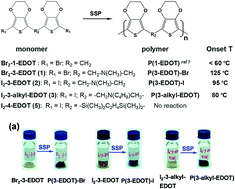Effect of flexible linker length in 3,4-ethylenedioxythiophene derivatives for solid state polymerization†
Abstract
Previously, we made a great breakthrough in solid state polymerization (SSP) for polythiophene by the new parallel design strategy of the introduction of a one-atom linker between the 3,4-ethylenedioxythiophene (EDOT) unit. Following this strategy, several EDOT derivatives with different lengths, by simply tuning the linker atoms number, were rationally designed, synthesized and studied as potential candidates for SSP. Now the question is raised here: does the flexible linker have a limited length for successful SSP? Here, we chose EDOT-linker-EDOT as a prototype monomer model due to its facile synthetic procedure and tunable flexible linker length. We examined up to a four-atom length and also investigated different halogen substituted effects. Detailed characterizations of their corresponding polymers were carried out and crystals of all the monomers were obtained for structures analysis. Our results reveal that the successful linker length of the monomers can be up to three atoms at least because the four-atom linker monomer failed to pass SSP due to its low melting point, though it has a preferred polymerization pathway according to the theoretical prediction based on its crystal structure. Moreover, the iodo-substituted monomer is inclined to form the corresponding polymer when compared with the bromo-substituted monomer. Furthermore, it is the first time that the molecule weight information of a polymer is obtained with the observation of its dependence on the temperature involved during the SSP. Our results are very important for fully understanding the SSP process, as well as for exploring monomer structures, for obtaining further rational design of new monomers and for tuning of the corresponding polymers properties.


 Please wait while we load your content...
Please wait while we load your content...